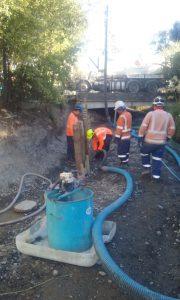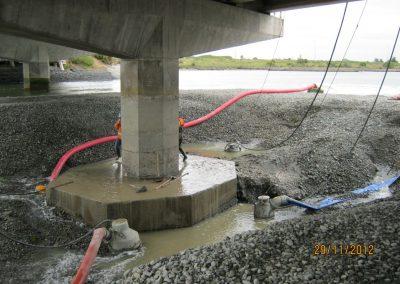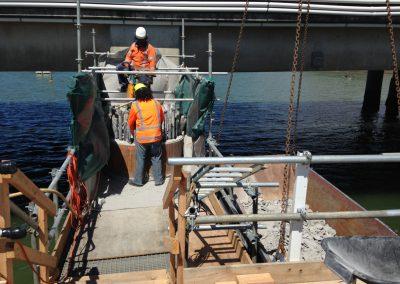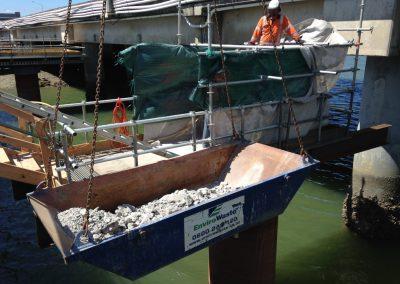Specific Tasks
Waterways
Other waterway tasks
Here are some quick tips for these other specific tasks in waterways:
Concrete

Grout container has secondary containment to minimise spills that could enter the waterway (Source: Downer).
At times, you will have to use concrete within a waterway. Some examples include:
- Building or strengthening retaining walls or abutments (the structural supports at the end of a bridge)
- Reinstating grouting
- Building any structures, eg punt stops, jetties, etc.
Concrete is a hazardous substance to introduce into a waterway so you must handle the process carefully.
Use whatever is possible out of these techniques:
- Isolate the work area from the waterway.
- Have a suitably qualified or experienced person remove all fish and eels from the isolated area. Transfer the fish and eels to suitable habitat.
- Dewater before work starts.
- For minor works, consider using flood protection barriers or hydrodams.
- Use bypass pumping.
- Have good scour protection.
- Use pre-cast concrete elements.
Issues to look out for:
- While the concrete is curing there will inevitably be some leakage into the bed. There is currently no effective way of monitoring this other than checking visually and looking for pH changes by comparing upstream and downstream.
- Using vibrating piles changes the river bed and increases the amount of suspended solids in the waterway.
- If your task includes gravel extraction, consult the Canterbury Regional Council River Gravel Extraction Code of Practice (PDF 4.6 MB).
-

Working with concrete around waterways (for example, on bridge piles or abutments) requires careful planning, operations and spill response measures (Source: Fulton Hogan).
-

Screens and staging installed to stop concrete and concrete dust dropping into the coastal marine area (Source: SouthernSkies).
-

Screens and staging installed to stop concrete and concrete dust dropping into the coastal marine area (Source: SouthernSkies).
Sediment removal and dredging
Removing sediment and dredging from a waterway is difficult, and requires good planning.
- Notify the local council of your intentions.
- Plan work to use the minimum area of bed.
- Isolate the area to be dredged from flowing water, if possible. Silt curtains and coffer dams are options to keep flowing water away from the dredging area.
- Use a suitably qualified or experienced person to remove all fish and eels from the work area. Transfer these animals to suitable habitat.
- Dredging without isolating the work area will create a sediment plume well downstream, so use (and enhance) natural features such as pools downstream as areas where sediment lost during the dredging can be collected and then removed later.
- If you are using an excavator to remove sediment, a toothed bucket may cause less sediment disturbance than a straight-edged bucket.
- Place dredgings straight into a truck for transport from the site. If this is not possible, put them well away from the water edge or bank edge. Protect the stream from additional sediment from the stockpiled dredgings by using filter socks or silt fences.
- Dredgings may contain fish and eels. Use suitably qualified or experienced people to remove any fish from the dredged material and return them to suitable habitat.
Weed removal
You may need to remove weeds from waterways, for example if the waterway is used for recreation, or to maintain flood capacity.
Isolate as much of the work area as you can, using silt curtains around the site and diverting water around it as necessary.
Removing vegetation on the banks of waterways can reduce habitat for Inanga/whitebait, so check for Inanga spawning areas.
Avoiding the time of the year between Inanga spawning and hatching will also avoid these effects. Use Environment Canterbury’s online Stock Exclusion Rules map to check. Use the Layer List button to display Inanga spawning habitats.
Be aware that the weeds themselves can also be a useful tool before you finally dispose of them. You can pile them up within a waterway to act as a temporary filter for sediment, like a baffle – the pile will capture the larger suspended solids.